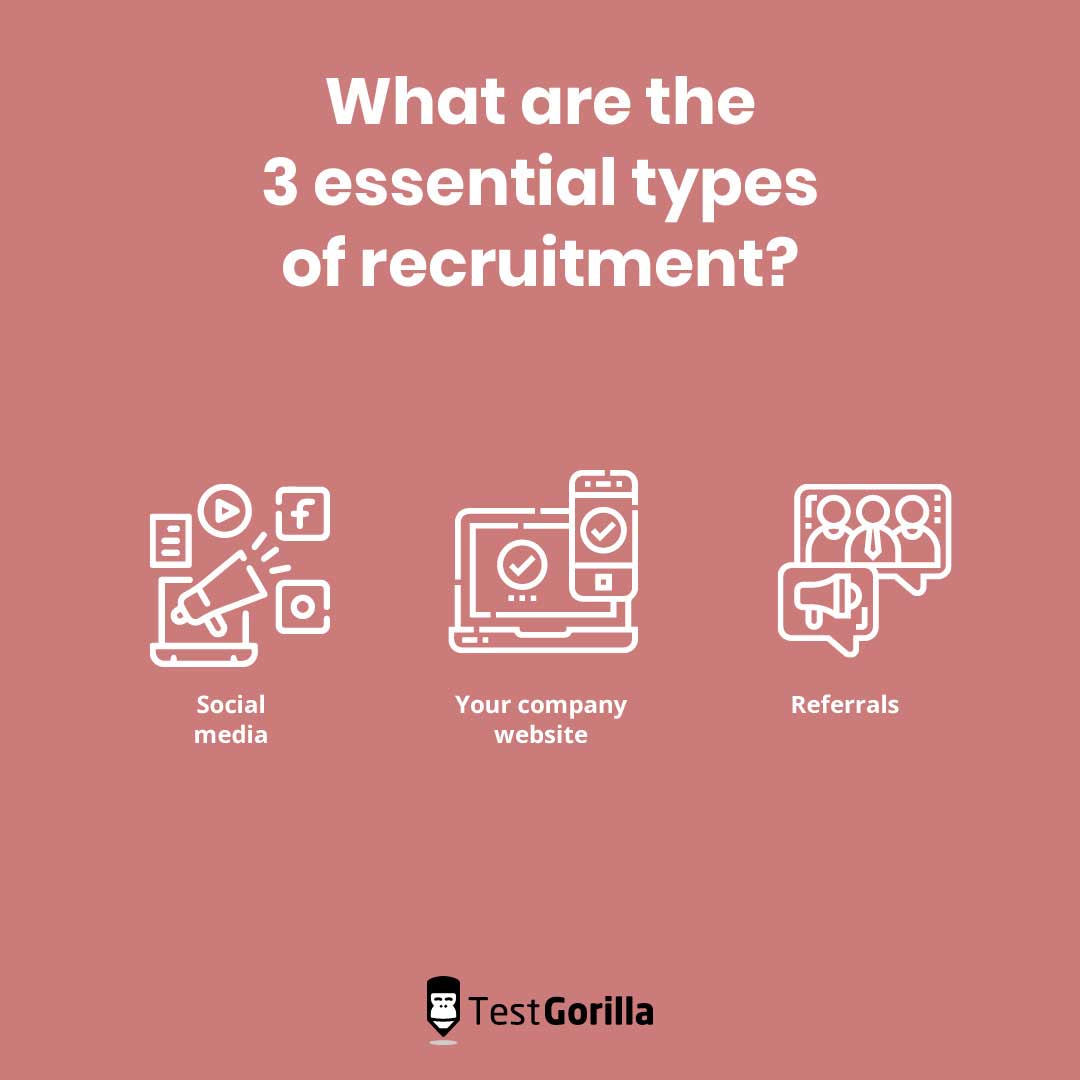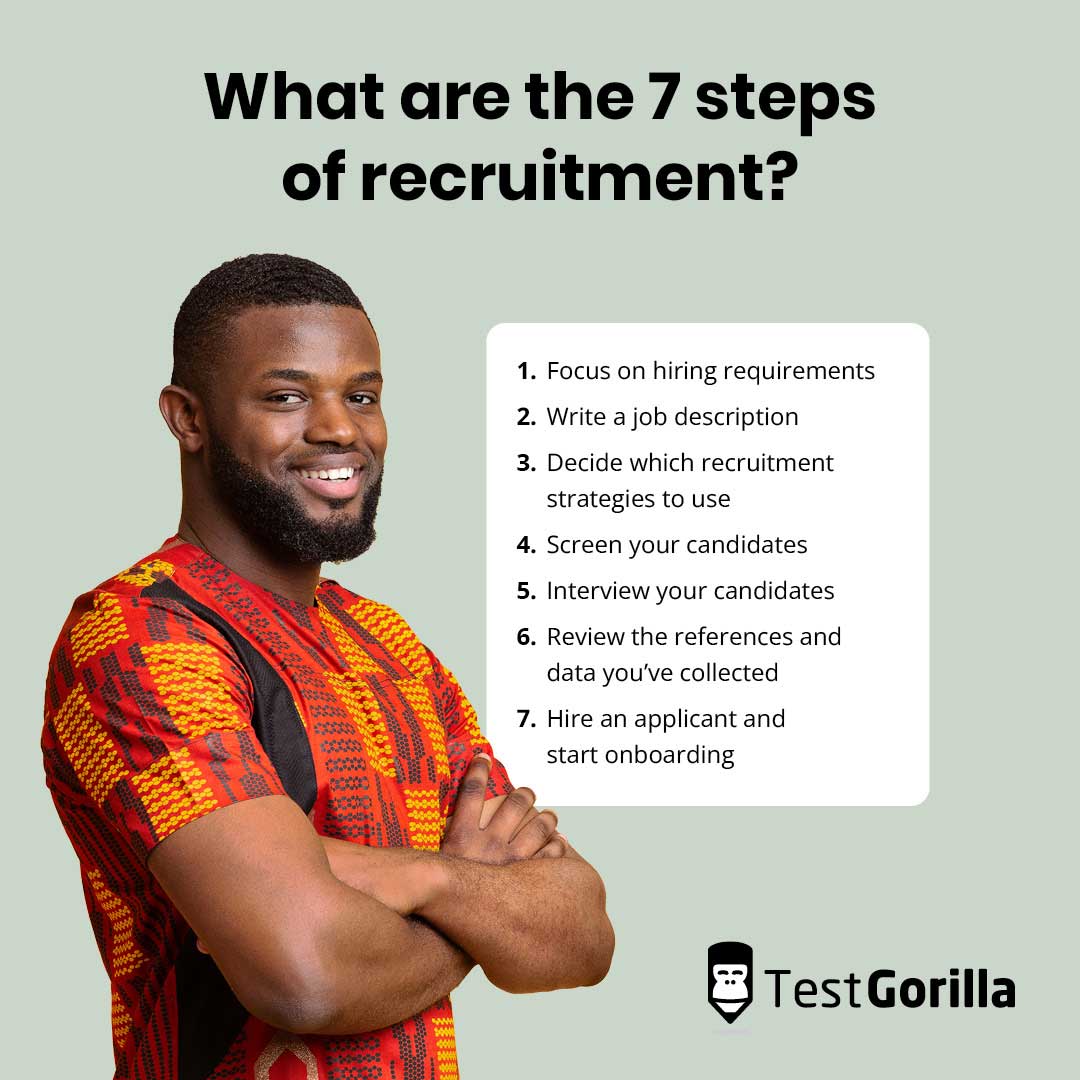You may already know that candidates reach your company via several recruitment channels or sources. These days, it can be challenging to know how your candidate first learned that your organization exists, but knowing where that first point of contact occurred can help you refine your recruitment practices.
What are the main sources of recruitment? How can you spot the top current hiring trends? This article has the information you’re looking for.
Table of contents
✅ Try out skills-based recruitment with a free TestGorilla account
What is the most common source of recruitment?
The most common source of recruitment to find suitable candidates is posting on job sites. This is the most popular way to source candidates despite offering a huge choice of candidates and requiring a time-consuming vetting process.
Job postings may have once caught applicants’ eyes from the pages of newspapers, but they have since migrated to online sources. Although 84% of small and medium-sized businesses struggle to find enough people to interview, job sites are still a top option for advertising vacancies.
What tools can you use on job sites to speed up the vetting process?
Plenty of online job boards offer options to review candidates’ skills with assessments.
However, you still have the option to use more robust skills-assessment platforms such as TestGorilla after you’ve sourced applicants. These are some of the best tools to use when sourcing and vetting candidates, offering a fast and objective method to review their knowledge and abilities.
To use skills assessments efficiently, give them to candidates immediately after they apply to your vacancy.
There are a few other sources of recruitment you can use skills-testing platforms with. So, which external recruitment methods are compatible with skills testing? Read on to learn more.
What are the 3 essential types of recruitment?
There are various sources of recruitment. Since leveraging these sources can work to your advantage, it helps to keep them fresh in your mind. Here are three types of recruitment to remember.
1. Social media
Unless you’re living under a rock, you probably know that social media networks are critical recruitment platforms these days. In fact, 86% of job seekers use social media to search and apply for jobs and engage with job-related content. You can use these external sources of recruitment to fill a vacancy with applicants who apply externally.
Chances are that most of your candidates will be on a social media network, such as LinkedIn or Twitter, meaning they’re ideal places to post job openings.
Beyond a simple posting, it’s possible to connect with potential followers by distributing information about your brand.
According to the LinkedIn report we referenced above, 73% of small and medium-sized businesses find it challenging to compete with better-known brands. However, even these companies can take entrepreneurial networking to the next level with social media. So build your brand and tell your story simultaneously on social channels.
2. Your company website
Your company website is one of the best places to post any job opportunities you want to fill because you can provide additional information unique to your organization, such as its benefits, charitable deeds, or corporate social responsibility initiatives.
Take the opportunity to use your company website as one of your sources of recruitment to sell your business to your candidates.
3. Referrals
Referrals are also a reliable and fast way to find top talent. They’re rising in popularity for many reasons. With this method, you can significantly reduce your recruiting costs, boost employee retention, and increase your workforce engagement.
Referral programs work best when you offer your employees an incentive for referring someone for a role, such as extra paid leave days or cash rewards.
What are the 7 steps of recruitment?
Handling recruitment can sometimes feel like juggling too many tasks at once, so here are the seven steps to successful hiring and how they relate to the critical sources of recruitment.
1. Focus on hiring requirements
Which requirements do you need to consider when hiring? Do you need to fill a vacancy because an employee has left the business? Do you need to find suitable talent for a new role? Identify the specific vacancy and consider which skills you need to find.
2. Write a job description
When writing a job description, include the job’s title, responsibilities, required skills, compensation, perks, and location. Consider using a buyer persona – a “character” that represents your ideal candidate, to determine which skills are essential to include in the job description.
3. Decide which recruitment strategies to use
Will you use internal recruitment strategies, such as referral recruitment? Will you use external methods, like posting the vacancy on a job board? Which location will you target when sourcing candidates? Consider these factors when thinking about which recruitment strategy to use.
4. Screen your candidates
You can skip straight to skills testing to screen your candidates instead of checking resumes.
For instance, if you’re hiring a content writer or marketing expert and need to see whether their skills align with your needs, give them a Technical SEO test to review these skills. You can shortlist candidates for the interview stage by taking note of their required credentials.
5. Interview your candidates
When interviewing candidates, ask them questions related to their experience and background, and then proceed to ask a list of hard- and soft-skills questions to learn more about their capabilities.
6. Review the references and data you’ve collected
Share your findings with your HR team and confer with them to make a hiring decision. After checking the skills-assessment results and re-reading your candidates’ interview responses, proceed with reference checking.
7. Hire an applicant and start onboarding
If everything checks out, extend an offer to your applicant and start the onboarding and training. Help your new employees understand their roles and responsibilities, and give them the required training and resources.
Choose the right sources of recruitment to hire top talent
It can be challenging to source top talent if you’re unfamiliar with the top hiring trends. That’s why it is always best to keep the best sources of recruitment in mind to refine your hiring process and hire top talent with effortless sourcing.
Remember that after using any of the sources of recruitment mentioned in this article, you can implement a skills-assessment method to ensure you’ve found a skilled applicant with the right knowledge to join your organization.
Try our HR Management test to hire HR professionals who can help you find top talent. You can create a free account with TestGorilla to get started.
Related posts
Hire the best candidates with TestGorilla
Create pre-employment assessments in minutes to screen candidates, save time, and hire the best talent.
Latest posts
The best advice in pre-employment testing, in your inbox.
No spam. Unsubscribe at any time.

Hire the best. No bias. No stress.
Our screening tests identify the best candidates and make your hiring decisions faster, easier, and bias-free.
Free resources
This checklist covers key features you should look for when choosing a skills testing platform
This resource will help you develop an onboarding checklist for new hires.
How to assess your candidates' attention to detail.
Learn how to get human resources certified through HRCI or SHRM.
Learn how you can improve the level of talent at your company.
Learn how CapitalT reduced hiring bias with online skills assessments.
Learn how to make the resume process more efficient and more effective.
Improve your hiring strategy with these 7 critical recruitment metrics.
Learn how Sukhi decreased time spent reviewing resumes by 83%!
Hire more efficiently with these hacks that 99% of recruiters aren't using.
Make a business case for diversity and inclusion initiatives with this data.





















